




Your support is critical to our success.
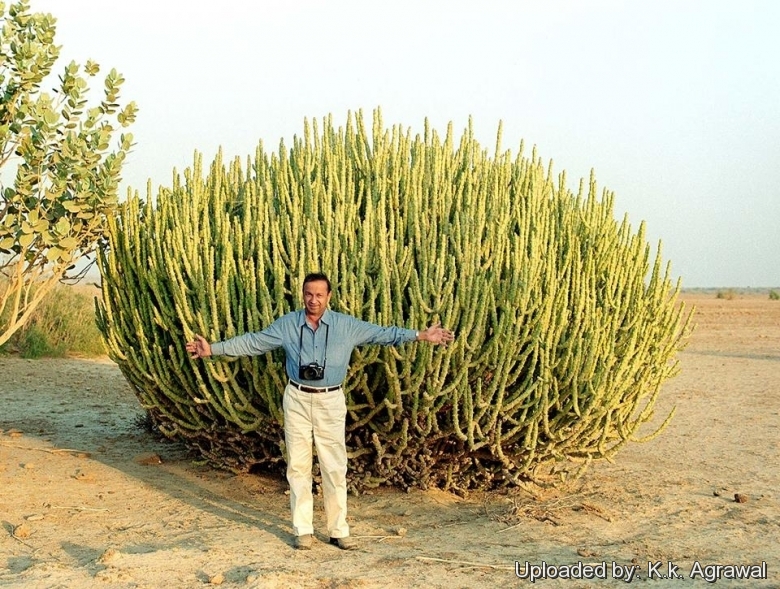
K.k. Agrawal showing a good group of Euphorbia Caducifolia near Jaisalmer, Rajasthan, India (1 novembre 2013)
Origin and Habitat: Euphorbia caducifoliaSN|28041]]SN|28041]] is a major species in rocky desert areas of western and central India and Pakistan.
Holotype: India, Madhya Pradesh, Satpura Hills, Raipur District
Altitude range: From sea level up to 600/800 meters.
Habitat and ecology: Euphorbia caducifoliaSN|28041]]SN|28041]] grows in stony ground on barren coastal plains and in the hilly tracts of the Indian desert on well-drained limestone soils as well on sandy soil, and therefore the substrate varies from slightly alkaline to slightly acidic. The plants covers almost the complete hillocks whenever they occurs. These areas undergo a marked dry season and the monsoon rains - though relatively partially blocked by a chain of mountains in the southeast - are abundant, but the the rain water flows quickly from the larger pore spaces of the coarse rocky substrate. It regenerates easily through dispersed seeds either alone or in association with over canopy trees. Once established in the rocky area, this species ameliorates microclimate including soil conditions that suited for regeneration and growth of other species. It forms favourite support for a number of climbers and becomes habitat for many other species.
Synonyms:
- Euphorbia caducifolia Haines
ENGLISH: Leafless Milk Hedge, Leafless Euphorbia
HINDI ( हिन्दी): थोर Thor, डंडा थोर Danda-thor
TELUGU (తెలుగు): Katte jemudu
Description: Euphorbia caducifoliaSN|28042]]SN|28041]] (a.k.a. Leafless Milk Hedge) is a great looking, sparsely spiny columnar branching Euphorbia. It is very similar to Euphorbia nivuliaSN|28041]]SN|28042]] (Leafy Milk Hedge). It differs chiefly in being a many-stemmed, cactus-like, shrub forming dense, dendride thickets up to 2(-3) m tall and 4(-10) m across, with numerus branches arising from the very base and at the top. It differentiate also in having smaller readily-falling leaf-blades. The plant is very variable in relation to the size and density of spines, the shape and size of leaves and the thickness and some times the colour of the stem.
Stems (phyllocladous stems): More or less erect, 3-5 cm in diameter, somewhat cylindrical, succulent, pale yellowish-green to green, vaguely angular with small, rather distant, slightly raised, non-confluent tubercles.
Stipular spine pairs: Blackish, 0.5-1 cm long, up 9 mm long, surrounding a growing point bearing the leaves.
Leaves: At stems' tips, sessile, falling quickly. Leaf-blades, oval, fleshy, very variable in size, 2.5-8 long and 2-5 cm broad.
Inflorescences (Cymes): Terminal 1-3-flowered produced from the apex of branches. Peduncle short and thick to 5 mm long.
Flowers (cyathia): Yellow (rarely reddish) about 5 mm in diameter with oblong and joined nectar glands.
Blooming season: Flowering in habitat February-March.
Fruits: Bright red approx 12 mm in diameter with 3 well-marked lobes.
Seeds: Spherical and smooth, approx 3 mm in diameter.
Bibliography: Major references and further lectures
1) Prof. R.K. Agarwal, Prof. V.K. Sangal “Krishna's Environment and Ecology” for B. Tech Ist and IInd semester students of All Engineering Colleges affiliated to U.P. Technical University, Lucknow; As per revised syllabus, w.e.f. 2008-09 Krishna Prakashan Media
2) Euphorbia caducifolia Haines http://www.efloras.org “Flora or Pakistan” version 2014.1. Accessed on 2014/07/12
3) Nasir, E. & S. I. Ali (eds). 1980-2005. Fl. Pakistan Univ. of Karachi, Karachi.
4) Goyal M, Sasmal D, Nagori BP. "GCMS analysis and antimicrobial action of latex of Euphorbia caducifolia." www.scopemed.org/?mno=19112 [Access: July 12, 2014].
5) Euphorbia caducifolia Haines in Ind. For. 40: 154. 1914.
6) Stewart, Ann. Cat. Vasc. Pl. W. Pak. & Kashm. 447. 1972.
7) G. Singh, “Facilitative effects of Euphorbia caducifolia and rehabilitation of degraded hills in dry areas” http://dlc.dlib.indiana.edu/dlc/bitstream/handle/10535/3828/Degradedhills.pdf?sequence=1 Division of Forest Ecology, Arid Forest Research Institute, New Pali Road, Jodhpur [Access: July 12, 2014].
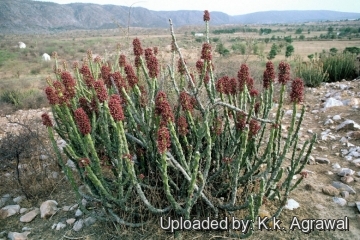
Euphorbia caducifolia Photo by: K.k. Agrawal
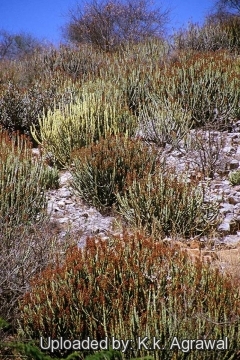
Euphorbia caducifolia Photo by: K.k. Agrawal
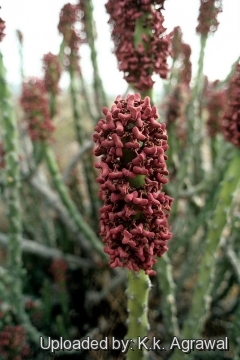
Euphorbia caducifolia Photo by: K.k. Agrawal
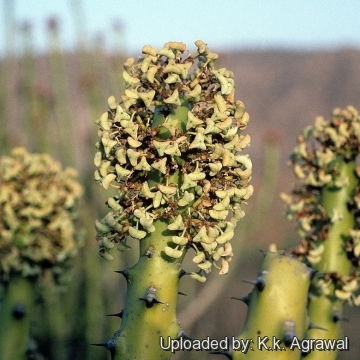
Euphorbia caducifolia Photo by: K.k. Agrawal
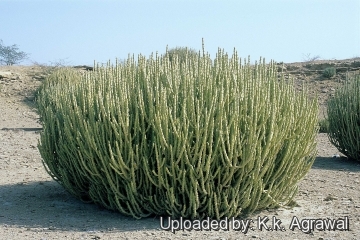
Euphorbia caducifolia Photo by: K.k. Agrawal
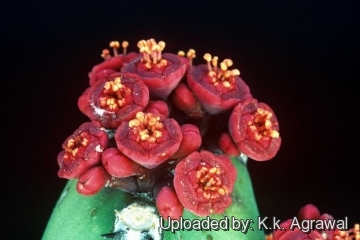
Euphorbia caducifolia Photo by: K.k. Agrawal

Euphorbia caducifolia Photo by: K.k. Agrawal
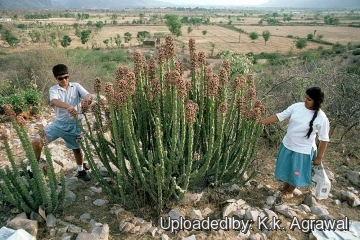
A picture of the past when we and our children used to go out to collect seeds of Euphorbia caducifolia in the hills. Photo by: K.k. Agrawal
Cultivation and Propagation: Euphorbia caducifoliaSN|28041]]SN|28041]] is an easy species to grow that is suited for any well drained soil in full sun. It needs no maintenance. But young plant are happy growing indoors. Paradoxically this common species in the tourist region of Rajasthan, India, is rare in cultivation in Europe and USA. Reproduction by stem cuttings and seeds is easy, but it seems, never offered for sale.
Growing rate: It is a moderately fast grower, and will quickly become large landscape masterpieces in just a few years. It is a long lived plant and once established, it will be content in its position and with its soil for years.
Soils: It grows well when in very draining soils when there is a layer of brick and charcoal pieces, on top of which sandy loam soil is spread. In pots give the plant an airy growing medium which mainly consists of non organic material such us clay, pumice, lava grit, and only a little peat or leaf-mould.
Repotting: It like quite small pots, repott in very later winter, early spring.
Watering: Water regularly during the active growing season from March to September. No water should ever be allowed to stand around the roots. Keep almost completely dry in winter.
Light: Full sun to filtered sun. It can tolerate moderate shade, and a plant that has been growing in shade should be slowly hardened off before placing it in full sun as the plant will be severely scorched if moved too suddenly from shade into sun.
Hardiness: Considered frost tender like all Indian Euphorbias, but surprisingly cold hardy outdoors and also very sun hardy for a succulent plant. It likes warmth (recommended minimum winter temperature 10° C) however plants kept perfectly dry can can survive low temperatures, approx. 0° C, but for safe cultivation it is best to avoid freezing temperatures. Never let the roots chill.
Maintenance: Can be pruned for shape and branching.
Plant Pests: Prone to mealy bugs and rarely scale.
Propagation: It is easy to propagate from seed or vegetatively in late spring to summer, just take a cutting of the plant let it dry for 1 or 2 weeks and stuff it in the ground (preferably dry, loose, extremely well draining soil). Cuttings will take root in a minimum temperature of 20° C (but better in hot weather).
Warning: All Euphorbias contain a white sap that can be irritating to eyes and mucous membranes. If contact is made with this white sap, take care to not touch face or eyes before washing hands with soap and water.
Uses:
1) Ornamental: The plant is used in parks and gardens for ornamentals and also for protective hedges, due to the fragility of its branches together with the well known skin irritancy of its latex. It can also be kept as an indoor ornamental plant.
2) Ethnobotany: The leaves of this species are boiled and eaten as a vegetable by the local population, after throwing the cooking water. It is used for the treatment of cough or application on the blisters, warts and pustules and applied to cuts and wounds for speedy healing. Pakistan young branches are burned and smoke inhaled to treat asthma.
3) Raw Materials for Petroleum Industries: Euphorbia caducifoliaSN|28041]]SN|28041]] is a very promising source of rich hydrocarbons (C-15 compounds), and is classed as a petrocrop. The oil obtained from the latex is close to diesel oil in its chemistry.
4) Other uses: It is utilized as fuel-wood after cutting and drying. The dried stalks are the cheapest of firewoods. It is commercially farmed for the latex and other chemicals.
| Your Actions | |
|---|---|
| Back to Euphorbia index | |
| Back to Euphorbiaceae index | |
 |
Back to Succulents Encyclopedia index |
Privacy stantement - Terms and conditions - How to cite - About us - Feedback - Donate





